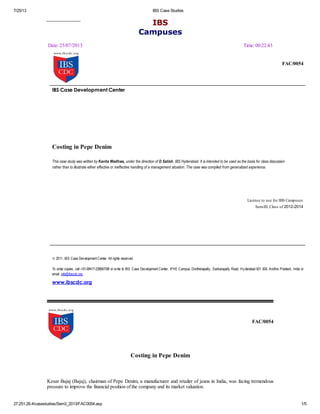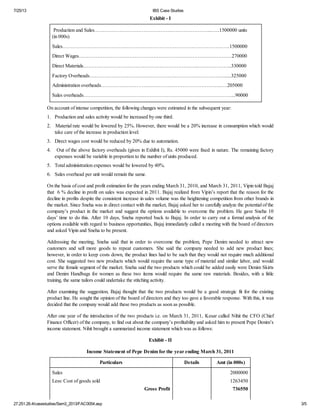Cost in denimpepe
- 1. 7/25/13 IBS Case Studies 27.251.26.4/casestudies/Sem3_2013/FAC0054.asp 1/5 IBS Campuses Date: 25/07/2013 Time: 00:22:43 FAC/0054 IBS Case Development Center Costing in Pepe Denim This case study was written by Kavita Wadhwa, under the direction of D Satish, IBS Hyderabad. It is intended to be used as the basis for class discussion rather than to illustrate either effective or ineffective handling of a management situation. The case was compiled from generalized experience. License to use for IBS Campuses Sem-III, Class of 2012-2014 ├ō 2011, IBS Case Development Center. All rights reserved. To order copies, call +91-08417-236667/68 or write to IBS Case Development Center, IFHE Campus, Donthanapally, Sankarapally Road, Hyderabad 501 504, Andhra Pradesh, India or email: info@ibscdc.org www.ibscdc.org FAC/0054 Costing in Pepe Denim Kesar Bajaj (Bajaj), chairman of Pepe Denim, a manufacturer and retailer of jeans in India, was facing tremendous pressure to improve the financial position of the company and its market valuation.
- 2. 7/25/13 IBS Case Studies 27.251.26.4/casestudies/Sem3_2013/FAC0054.asp 2/5 Bajaj and his younger brother Dinkar had floated Pepe Denim as a private limited company in Ahmedabad, Gujarat, in 1984. In 1994, the brothers decided to convert the company into a public limited company. Pepe Denim began manufacturing operations with just one factory in Ahmedabad district but the brothers put in a lot of hard work and took the company to a level where in 2011, it had 300 stores spread throughout the country and a workforce of 20,000. It also used to export its jeans to China, Brazil, and Nepal. Till 2007, the company did very good business with its sales increasing every year. It earned exceptional growth in valuation resulting from an increase in the companyŌĆÖs stock prices. After 2007, however, the stock prices of the company started to decline even though sales continued to be consistent. Though there was no decrease in sales, the profits began to fall. The brothers thought that the decline in the stock prices and profits was due to the economic slowdown and recession. Since there was consistency in sales, they concluded that the profits were declining because of the increase in costs due to inflation. But the stock prices of the company remained flat and profits continued to decline even after 2010 when the economy had started reviving, stock indices had started rising, and the stock prices of other companies had also started soaring. The shareholders of the company raised concerns over the declining profits of the company. As a result of a heated shareholdersŌĆÖ meeting, Bajaj came under pressure to improve the companyŌĆÖs financial position and its market valuation. In order to understand the present status of production, costs, sales, and the future prospects of the companyŌĆÖs product in the market, he immediately called Vipin, the companyŌĆÖs cost accountant, and Sneha, the marketing manager. Vipin furnished the following cost information (Refer to Exhibit I) for the year ending March 31, 2010, and the changes in costs which were expected in the coming year:
- 3. 7/25/13 IBS Case Studies 27.251.26.4/casestudies/Sem3_2013/FAC0054.asp 3/5 Exhibit - I Production and SalesŌĆ”ŌĆ”ŌĆ”ŌĆ”ŌĆ”ŌĆ”ŌĆ”ŌĆ”ŌĆ”ŌĆ”ŌĆ”ŌĆ”ŌĆ”ŌĆ”ŌĆ”.ŌĆ”ŌĆ”ŌĆ”ŌĆ”ŌĆ”ŌĆ”ŌĆ”...ŌĆ”..1500000 units (in 000s) SalesŌĆ”ŌĆ”ŌĆ”ŌĆ”ŌĆ”ŌĆ”ŌĆ”ŌĆ”ŌĆ”ŌĆ”ŌĆ”ŌĆ”ŌĆ”ŌĆ”ŌĆ”ŌĆ”ŌĆ”ŌĆ”ŌĆ”ŌĆ”ŌĆ”ŌĆ”ŌĆ”ŌĆ”ŌĆ”ŌĆ”ŌĆ”ŌĆ”ŌĆ”ŌĆ”ŌĆ”.ŌĆ”..1500000 Direct WagesŌĆ”ŌĆ”ŌĆ”ŌĆ”ŌĆ”ŌĆ”ŌĆ”ŌĆ”ŌĆ”ŌĆ”ŌĆ”ŌĆ”ŌĆ”ŌĆ”ŌĆ”ŌĆ”ŌĆ”ŌĆ”ŌĆ”ŌĆ”ŌĆ”ŌĆ”ŌĆ”ŌĆ”ŌĆ”ŌĆ”ŌĆ”ŌĆ”ŌĆ”ŌĆ”270000 Direct MaterialsŌĆ”ŌĆ”ŌĆ”ŌĆ”ŌĆ”ŌĆ”ŌĆ”ŌĆ”ŌĆ”ŌĆ”ŌĆ”ŌĆ”ŌĆ”ŌĆ”ŌĆ”ŌĆ”ŌĆ”ŌĆ”ŌĆ”ŌĆ”ŌĆ”ŌĆ”..ŌĆ”ŌĆ”ŌĆ”ŌĆ”ŌĆ”ŌĆ”..330000 Factory OverheadsŌĆ”ŌĆ”ŌĆ”ŌĆ”ŌĆ”ŌĆ”ŌĆ”ŌĆ”ŌĆ”ŌĆ”ŌĆ”ŌĆ”ŌĆ”ŌĆ”ŌĆ”ŌĆ”ŌĆ”ŌĆ”ŌĆ”ŌĆ”ŌĆ”ŌĆ”ŌĆ”ŌĆ”ŌĆ”ŌĆ”.......325000 Administration overheadsŌĆ”ŌĆ”ŌĆ”ŌĆ”ŌĆ”ŌĆ”ŌĆ”ŌĆ”ŌĆ”ŌĆ”ŌĆ”ŌĆ”ŌĆ”ŌĆ”ŌĆ”ŌĆ”ŌĆ”ŌĆ”ŌĆ”ŌĆ”ŌĆ”ŌĆ”ŌĆ”..ŌĆ”.205000 Sales overheadsŌĆ”ŌĆ”ŌĆ”ŌĆ”ŌĆ”ŌĆ”ŌĆ”ŌĆ”ŌĆ”ŌĆ”ŌĆ”ŌĆ”ŌĆ”ŌĆ”ŌĆ”ŌĆ”ŌĆ”ŌĆ”ŌĆ”ŌĆ”ŌĆ”ŌĆ”ŌĆ”ŌĆ”ŌĆ”ŌĆ”ŌĆ”ŌĆ”ŌĆ”...90000 On account of intense competition, the following changes were estimated in the subsequent year: 1. Production and sales activity would be increased by one third. 2. Material rate would be lowered by 25%. However, there would be a 20% increase in consumption which would take care of the increase in production level. 3. Direct wages cost would be reduced by 20% due to automation. 4. Out of the above factory overheads (given in Exhibit I), Rs. 45000 were fixed in nature. The remaining factory expenses would be variable in proportion to the number of units produced. 5. Total administration expenses would be lowered by 40%. 6. Sales overhead per unit would remain the same. On the basis of cost and profit estimation for the years ending March 31, 2010, and March 31, 2011, Vipin told Bajaj that 6 % decline in profit on sales was expected in 2011. Bajaj realized from VipinŌĆÖs report that the reason for the decline in profits despite the consistent increase in sales volume was the heightening competition from other brands in the market. Since Sneha was in direct contact with the market, Bajaj asked her to carefully analyze the potential of the companyŌĆÖs product in the market and suggest the options available to overcome the problem. He gave Sneha 10 daysŌĆÖ time to do this. After 10 days, Sneha reported back to Bajaj. In order to carry out a formal analysis of the options available with regard to business opportunities, Bajaj immediately called a meeting with the board of directors and asked Vipin and Sneha to be present. Addressing the meeting, Sneha said that in order to overcome the problem, Pepe Denim needed to attract new customers and sell more goods to repeat customers. She said the company needed to add new product lines; however, in order to keep costs down, the product lines had to be such that they would not require much additional cost. She suggested two new products which would require the same type of material and similar labor, and would serve the female segment of the market. Sneha said the two products which could be added easily were Denim Skirts and Denim Handbags for women as these two items would require the same raw materials. Besides, with a little training, the same tailors could undertake the stitching activity. After examining the suggestion, Bajaj thought that the two products would be a good strategic fit for the existing product line. He sought the opinion of the board of directors and they too gave a favorable response. With this, it was decided that the company would add these two products as soon as possible. After one year of the introduction of the two products i.e. on March 31, 2011, Kesar called Nihit the CFO (Chief Finance Officer) of the company, to find out about the companyŌĆÖs profitability and asked him to present Pepe DenimŌĆÖs income statement. Nihit brought a summarized income statement which was as follows: Exhibit - II Income Statement of Pepe Denim for the year ending March 31, 2011 Particulars Details Amt (in 000s) Sales Less: Cost of goods sold Gross Profit 2000000 1263450 736550
- 4. 7/25/13 IBS Case Studies 27.251.26.4/casestudies/Sem3_2013/FAC0054.asp 4/5 Less: Indirect expenses Office expenses Selling and distribution expenses Net Profit before depreciation Less: Depreciation Net Profit after depreciation Less: Tax (40%) Profit after tax 129150 126000 255150 481400 16400 465000 186000 279000 From the income statement, Bajaj calculated the profit before tax percentage on sales and it worked out to be 23.25 ŌĆö 4.25 per cent higher than the previous yearŌĆÖs profit. This improvement in profit gave him some satisfaction and he was eager to know how the new products were performing and what their cost structures were. He asked Vipin to present the cost sheet of Denim Skirts and Denim Handbags. Vipin was not ready with the cost sheets and so presented the following cost details of all the products: Exhibit - III (Amount in 000s) Particulars Jeans Denim Skirts Denim Handbags Stock of materials as on April 1, 2010 200000 ŌĆ”ŌĆ”ŌĆ”.. ŌĆ”ŌĆ”ŌĆ”.. Stock of materials as on March 31, 2011 150000 75000 25000 Material purchased during the year 600000 300000 100000 Sale of material (not suitable) 25000 Work-in-progress as on April 1, 2010 100000 ŌĆ”ŌĆ”ŌĆ”.. ŌĆ”ŌĆ”ŌĆ”.. Work-in-progress as on March 31, 2011 35000 10000 5000 Finished Stock as on April 1, 2010 350000 ŌĆ”ŌĆ”ŌĆ”.. ŌĆ”ŌĆ”ŌĆ”.. Finished Stock as on March 31, 2011 450000 200000 120000 Salaries (Factory) 15350 10000 5000 Office salaries 25000 15000 5000 Carriage on purchases 12000 6000 2000 Carriage on sales 13000 5000 2000 Cash discount allowed 1800 550 400 Bad debts written off 8000 1500 500 Repairs of plant, machinery, and tools 8000 4000 1600 Rent, rates, taxes, and insurance (factory) 12000 6000 2000 Rent, rates, taxes, and insurance (office) 2000 700 300 Traveling expenses 7000 5000 3000 TravelerŌĆÖs salaries and commission 20000 13000 7000 Productive wages 300000 120000 180000 Depreciation written off on plant, machinery, tools 9000 3000 2000 Depreciation written off on office furniture 1800 400 200 DirectorŌĆÖs fees 15000 7000 3000 Dyeing and water charges (factory) 3000 1500 500 Gas and water charges (office) 850 300 100
- 5. 7/25/13 IBS Case Studies 27.251.26.4/casestudies/Sem3_2013/FAC0054.asp 5/5 General charges 12750 5000 3000 ManagerŌĆÖs salary (Office) 8000 5000 2000 ManagerŌĆÖs salary (factory) 10000 6900 5000 Advertising 28000 21000 8750 Required: 1) Vipin told Kesar Bajaj that a 6 % decline in profit on sales was expected in 2011. If the given information is correct then what would be the selling price of a pair of jeans for the year ending March 31, 2011? 2) Can you help Kesar Bajaj in getting the total cost estimate of all the three products ŌĆō Jeans, Denim Skirts, and Denim Handbags? If yes, what is the total cost of all three products? 3) You are required to reconcile the profit with the Income Statement. 4) Do you think the decision of the company to add two new products was beneficial? If yes, how? Exit





